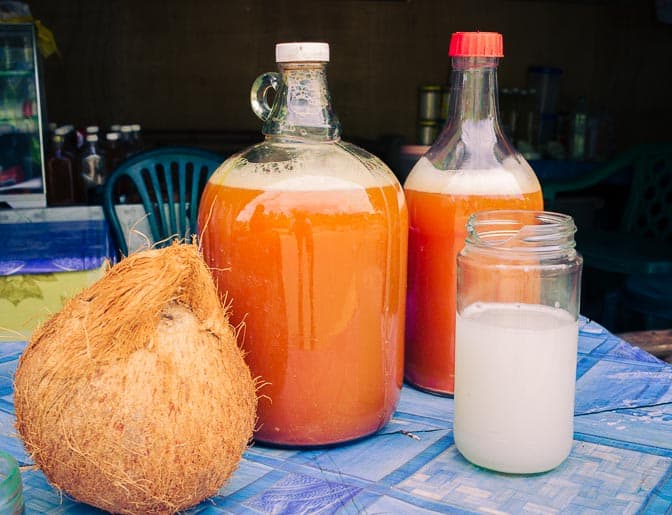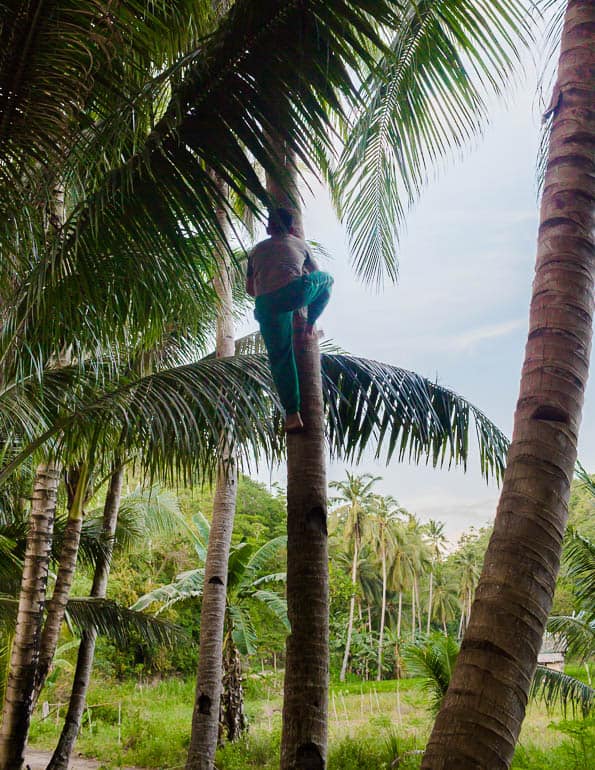In the Philippines, we were told about a coconut wine called Tuba. It was the first time we heard about it and we got interested in the first moment. After all, wine and coconut always sound great. As we are very curious people, we decided to go look for it. We started asking here, there, and finally, we got a contact.
—Tuba? Do you guys want to try Tuba? Are you serious? You can find it at Mr ‘X’ shop.
Tasting coconut wine
We thought that Mr X’s shop would be some kind of a warehouse selling bottles of alcoholic beverages and one of it would be a tuba bottle. Definitely, it was not even close to that. The shop was a small house on the main road of the island, a simple counter facing the street. An older couple, who looked like the shop owners, was talking with a client sitting by the counter.
— Kumusta ka? (That’s how you say “How are you?” in Filipino. Very similar to Spanish and Portuguese)
— We would like to try Tuba. He gave us a big smile, took his gallon with an orange liquid, and brought it for us to try. It was good, it had the taste and the strong smell of natural fermentation. On that night, we were planning to grill a fish on the banana leaf so we wanted to bring some Tuba with us to the hotel.
— Can we take some with us?
— How many litres?
— Just a little bit! We just want to try it out a bit more.
He went to the back of the house, took an empty bottle, filled it up and gave it to us. The old lady told us that coconut wine gets stronger at night, and recommended us to try it fresh in the morning if we have the opportunity. The communication in English was challenging but we wanted to learn more about that orange liquid which they say it comes from the coconut.
As we knew nothing about that, we were still associating coconut wine with the conventional wineries model. We were thinking about some ‘winery’ that produces coconut wine.
— We would like to see the production of Tuba. Is it possible? Who produces Tuba on the island?
— The coconut tree.
— Yes, but what about the fermentation process, can we see the process?
— It’s in the morning. They cut the coconut tree every day.
Ohhh! She’s not understanding us.
But, she was…
What is coconut wine
After discovering how coconut wine looks like, we began to recognize Tuba being sold in many places around Siquijor, the island we were. We started to stop at roadside shops to have a drink and try to learn more about it.
After researching, we found that this coconut wine is common in several countries. In the Philippines it is called Tuba, in India it is known as Toddy, in Indonesia is Tuak, in Angola is Manjenvo and so on…
We learned that Tuba is nothing more than the fermentation of the sap taken from coconut tree or other types of palm trees. In the Philippines, the Tuba which is consumed is mainly from the sap of coconut palm and that’s why they call it coconut wine.
The person who harvests the sap is known as Tapper. He climbs the coconut tree, makes a cut in the inflorescence and ties a gallon to collect the sap. The production of Tuba requires a routine of climbing the coconut tree twice a day. At the end of the day, the collector goes up to make a pruning in the inflorescence so the sap drips in the gallon during the night. At sunrise, he climbs the coconut tree again and removes the collected sap from the gallon. This sap is then ready for sale.
If you drink the coconut tree sap at the moment it is collected, you feel a super sweet drink with very little alcohol content. However, the fermentation is fast and in 3-4 days it can already become vinegar. If the temperature is controlled, it is possible to have a longer fermentation. It is also common to distil the sap and turn into a kind of vodka. In the Philippines, it is called Lambanog.
The natural colour of the sap is milky white, but in some islands of the Philippines, there is a popular preference for the orange colour. This colour comes from chunks of a tree trunk that are added in the process. They say that it is a natural additive which helps to slow down the fermentation process.
The quest for coconut wine trees
We were fascinated by all that, we wanted to know more about coconut wine. We are from Brazil. C’mon! We have so many coconut trees in our country, how did we not know about it? We began again with the “ask here and there” strategy until someone told us a region on the island where Tuba is harvested. The quest to find different ingredients is always one of the best parts of our trip.
By motorbike, we crawled into the island of Siquijor. The more we drove, the more local everything was. There weren’t many people to ask for information, but we found some boys near the entrance of a waterfall.
— Hi! We want to see Tuba production. Do you know anyone?
— Tuba? Yes, come here, we’ll take you there.
That was the conversation, no more words. The two boys climbed on a motorbike and waved for us to follow them. This is one of those moments that amazes you for three things. First, you understand what hospitality is and how incredible and touching it can be. Second, you realize how the context where you grow up shape our behaviours. We are Brazilians who lived for ten years in the city of Sao Paulo, follow two boys on a motorcycle that you don’t know towards the middle of an island, is not something advisable. And third, to realize how travelling makes you break these fears and find out that there are many good people in this world.
Check out how to harvest coconut wine
Finally, the harvest of coconut wine
We arrived in a very simple house, some chickens in the backyard, a father, a mother and their children. In the Philippines, English is well spoken especially by young people. We told them that we came to learn more about the harvest of Tuba. Everyone was surprised! Certainly, not many travellers have this interest. The father of the family was the tapper. He told us that the coconut trees that produce the wine are dedicated solely for this. We were there in the afternoon, it was not the time to harvest the sap, but he still showed us how to do it. He climbed the tree with his machete, trimmed the inflorescence, collected the sap that was already in the gallon and came down with the fresh Tuba. We drank right there with the family and the boys who helped us to find them. As a bonus, the man still climbed another coconut tree and came down with one of the freshest coconuts we’ve ever taken.
In the end, we understood what the lady from the shop meant. Who makes the coconut wine is indeed the coconut tree.



